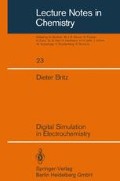Abstract
This book is about the application of digital simulation (DS) to electrochemical problems. What is digital simulation? The term “simulation” came into wide use with the advent of analog computers, which could produce electrical signals that followed mathematical functions which might describe or model a given physical system. When digital computers became common, people began to do these simulations digitally and called this digital simulation. What sort of systems do we simulate in electrochemistry? Most commonly it is electrochemical transport problems that we find difficult to solve, in all but a few model systems — when things get more complicated, as they do in real electrochemical cells, problems may not be solvable algebraically, yet we still want answers.
Access this chapter
Tax calculation will be finalised at checkout
Purchases are for personal use only
Preview
Unable to display preview. Download preview PDF.
References
L.F. Richardson, Phil. Trans. A210 (1911) 307.
E. Schmidt, A. Föppel Festschr. (1924) 179.
R. Courant, K. Friedrichs and H. Lewy, Math. Ann. 100 (1928).
H.W. Emmons, Quart. Appl. Meth. 2 (1944) 173
F.F. Abraham and W.A. Tiller, “An Introduction to Computer Simulation in Applied Science”, Plenum Press, 1972.
W.F. Ames, “Numerical Methods for Partial Differential Equations”, Academic Press, 1977.
L. Collatz, “The Numerical Treatment of Differential Equations”, Springer, 1960.
G.E. Forsythe and W.R. Wasow, “Finite-Difference Methods for Partial Differential Equations”, Wiley, 1960.
R.D. Richtmyer and K.W. Morton, “Difference Methods for Initial Value Problems”, Wiley, 1967.
G.D. Smith, “Numerical Solution of Partial Differential Equations”, Oxford University Press, 1965.
S.W. Feldberg and C. Auerbach, Anal. Chem. 36 (1964) 505.
Q.E.B. Randles, Trans. Faraday Soc. 44 (1948) 327.
S.W. Feldberg, Electroanal. Chem. (Ed. Bard) 3 (1969) 199.
Author information
Authors and Affiliations
Rights and permissions
Copyright information
© 1981 Springer-Verlag Berlin Heidelberg
About this chapter
Cite this chapter
Britz, D. (1981). Introduction. In: Digital Simulation in Electrochemistry. Lecture Notes in Chemistry, vol 23. Springer, Berlin, Heidelberg. https://doi.org/10.1007/978-3-662-21819-8_1
Download citation
DOI: https://doi.org/10.1007/978-3-662-21819-8_1
Publisher Name: Springer, Berlin, Heidelberg
Print ISBN: 978-3-540-10564-0
Online ISBN: 978-3-662-21819-8
eBook Packages: Springer Book Archive

